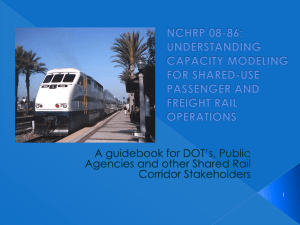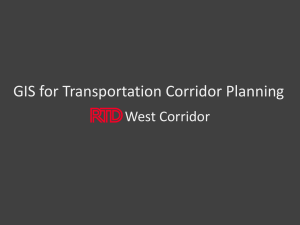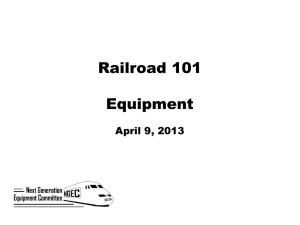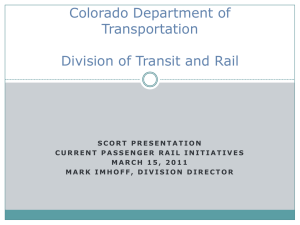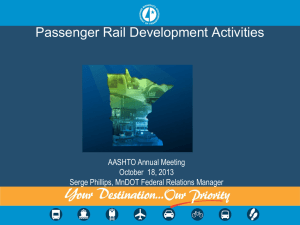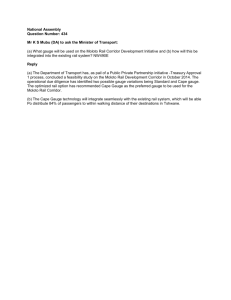Bill Id: - Around The Capitol
advertisement
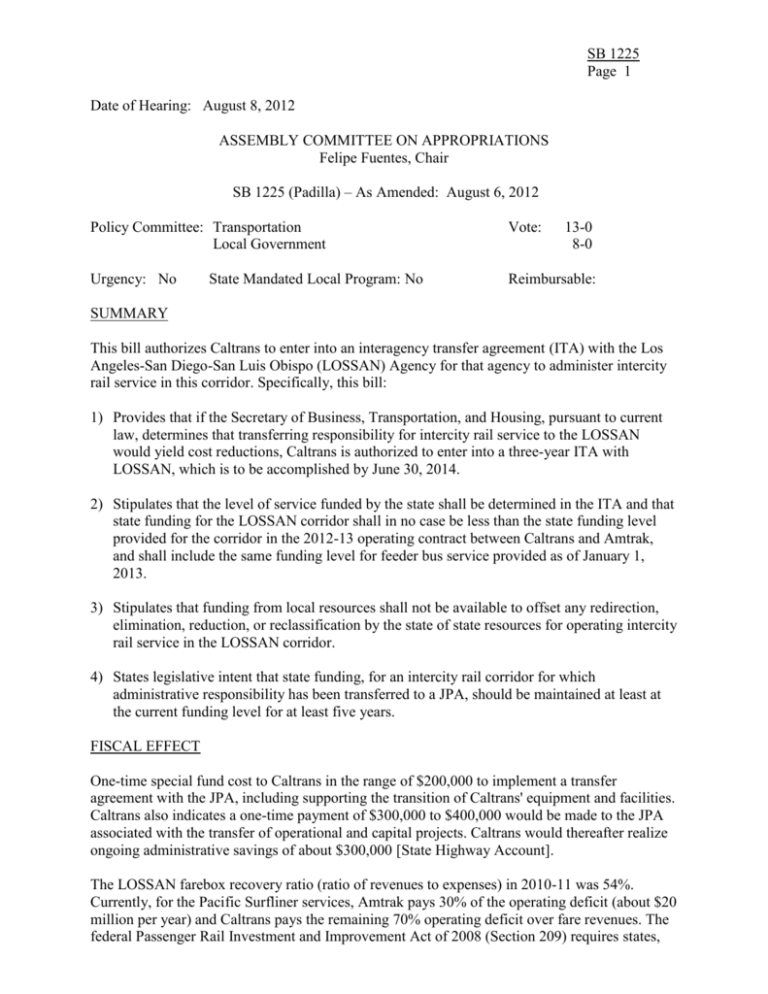
SB 1225 Page 1 Date of Hearing: August 8, 2012 ASSEMBLY COMMITTEE ON APPROPRIATIONS Felipe Fuentes, Chair SB 1225 (Padilla) – As Amended: August 6, 2012 Policy Committee: Transportation Local Government Vote: Urgency: No Reimbursable: State Mandated Local Program: No 13-0 8-0 SUMMARY This bill authorizes Caltrans to enter into an interagency transfer agreement (ITA) with the Los Angeles-San Diego-San Luis Obispo (LOSSAN) Agency for that agency to administer intercity rail service in this corridor. Specifically, this bill: 1) Provides that if the Secretary of Business, Transportation, and Housing, pursuant to current law, determines that transferring responsibility for intercity rail service to the LOSSAN would yield cost reductions, Caltrans is authorized to enter into a three-year ITA with LOSSAN, which is to be accomplished by June 30, 2014. 2) Stipulates that the level of service funded by the state shall be determined in the ITA and that state funding for the LOSSAN corridor shall in no case be less than the state funding level provided for the corridor in the 2012-13 operating contract between Caltrans and Amtrak, and shall include the same funding level for feeder bus service provided as of January 1, 2013. 3) Stipulates that funding from local resources shall not be available to offset any redirection, elimination, reduction, or reclassification by the state of state resources for operating intercity rail service in the LOSSAN corridor. 4) States legislative intent that state funding, for an intercity rail corridor for which administrative responsibility has been transferred to a JPA, should be maintained at least at the current funding level for at least five years. FISCAL EFFECT One-time special fund cost to Caltrans in the range of $200,000 to implement a transfer agreement with the JPA, including supporting the transition of Caltrans' equipment and facilities. Caltrans also indicates a one-time payment of $300,000 to $400,000 would be made to the JPA associated with the transfer of operational and capital projects. Caltrans would thereafter realize ongoing administrative savings of about $300,000 [State Highway Account]. The LOSSAN farebox recovery ratio (ratio of revenues to expenses) in 2010-11 was 54%. Currently, for the Pacific Surfliner services, Amtrak pays 30% of the operating deficit (about $20 million per year) and Caltrans pays the remaining 70% operating deficit over fare revenues. The federal Passenger Rail Investment and Improvement Act of 2008 (Section 209) requires states, SB 1225 Page 2 starting October 1, 2013, to pay 100% of the costs of short-distance intercity Amtrak services and capital costs. SB 1225 establishes 2012-13 as the time period upon which the state funding level amount is to be maintained for a three-year period, which pre-dates the time when the state will lose the current $20 million Amtrak subsidy, thus the bill does not create a mandated state backfill of this amount. Notwithstanding the above, however, the bill also creates cost pressure by expressing legislative intent to maintain funding for three years at a level at least equal to the "current level of service" in the corridor. Fulfilling this intent would require a state backfill for the $20 million Amtrak subsidy. This inconsistency should be addressed by changing this language to "current level of funding". COMMENTS 1) Background. Intercity passenger rail service is a component of the state's overall transportation system and operates between several regions of the state. Intercity services include three state-supported corridor routes and four Amtrak long-distance routes. The three in-state intercity routes were funded, planned and administered by Caltrans until July 1998, when the Capitol Corridor JPA assumed administration of the Auburn-Sacramento-OaklandSan Jose corridor. (The CCJPA was established through SB 457 (Kelley)/Chapter 263 of 1996.) The other two intercity rail passenger services, the Pacific Surfliner and the San Joaquin continue to be administered by Caltrans. The 351-mile-long LOSSAN rail corridor (San Diego to Los Angeles to San Luis Obispo) is the second busiest passenger rail corridor in the nation, second only to the Boston-toWashington D.C. Northeast Corridor. More than nine million passenger riders make trips on LOSSAN corridor commuter and intercity trains annually. The corridor runs through a sixcounty area, connecting major metropolitan areas of Southern California and the Central Coast. There are three passenger rail carriers along this route: Amtrak's intercity service and the Metrolink and Coaster commuter lines. Amtrak operates both the long distance intercity Coast Starlight (Los Angeles to Seattle) and the Pacific Surfliner passenger trains. The Pacific Surfliner route (essentially comprising the LOSSAN rail corridor) is under the administration of Caltrans. 2) LOSSAN Corridor Agency. To coordinate the interconnected rail passenger intercity and commuter services within the Pacific Surfliner corridor, the LOSSAN corridor agency was formed as JPA in 1989. The Los Angeles County Metropolitan Transportation Authority, Orange County Transportation Authority, North County Transportation District, San Diego Association of Governments, San Diego Metropolitan Transit System, San Luis Obispo Council of Governments, Santa Barbara County Association of Governments, Ventura County Transportation Commission, and Caltrans are voting members of the JPA. The Southern California Association of Governments, Amtrak, and the California High-Speed Rail Authority are non-voting, ex-officio members of the JPA. There are four additional non-voting technical advisory committee members representing the Burlington Northern Sante Fe Railroad, the California Public Utilities Commission, the Southern California Regional Rail Agency, and Union Pacific Railroad. SB 1225 Page 3 The LOSSAN corridor agency advises Caltrans, as administrator of the corridor, on Amtrak services and facility improvements within the corridor. Legislation enacted in 1996 provided an opportunity for the LOSSAN corridor agency to create a JPA to assume responsibility for the LOSSAN intercity passenger service by December 31, 1996. An agreement with Caltrans could not be reached because the local agencies were unable to reach a timely consensus on the structure of the corridor agency. Accordingly, the responsibility for the service remains with Caltrans. This bill is the second attempt for the separate agencies to reach consensus on an interagency transfer agreement. 3) Purpose. The member agencies argue that placing passenger rail service in the LOSSAN corridor under local management will result in a more efficient and effective allocation of resources and decision-making related to service expansion, frequencies, extensions, connectivity, and schedules. They further contend that a unified voice will be more effective at the state and federal level when advocating on passenger rail issues, including funding for capital improvements. 4) Related Legislation. AB 1779 (Galgiani), pending in Senate Appropriations, provides for the establishment of a joint powers agency (JPA) to administer intercity rail service in the San Joaquin Valley. Analysis Prepared by: Chuck Nicol / APPR. / (916) 319-2081


